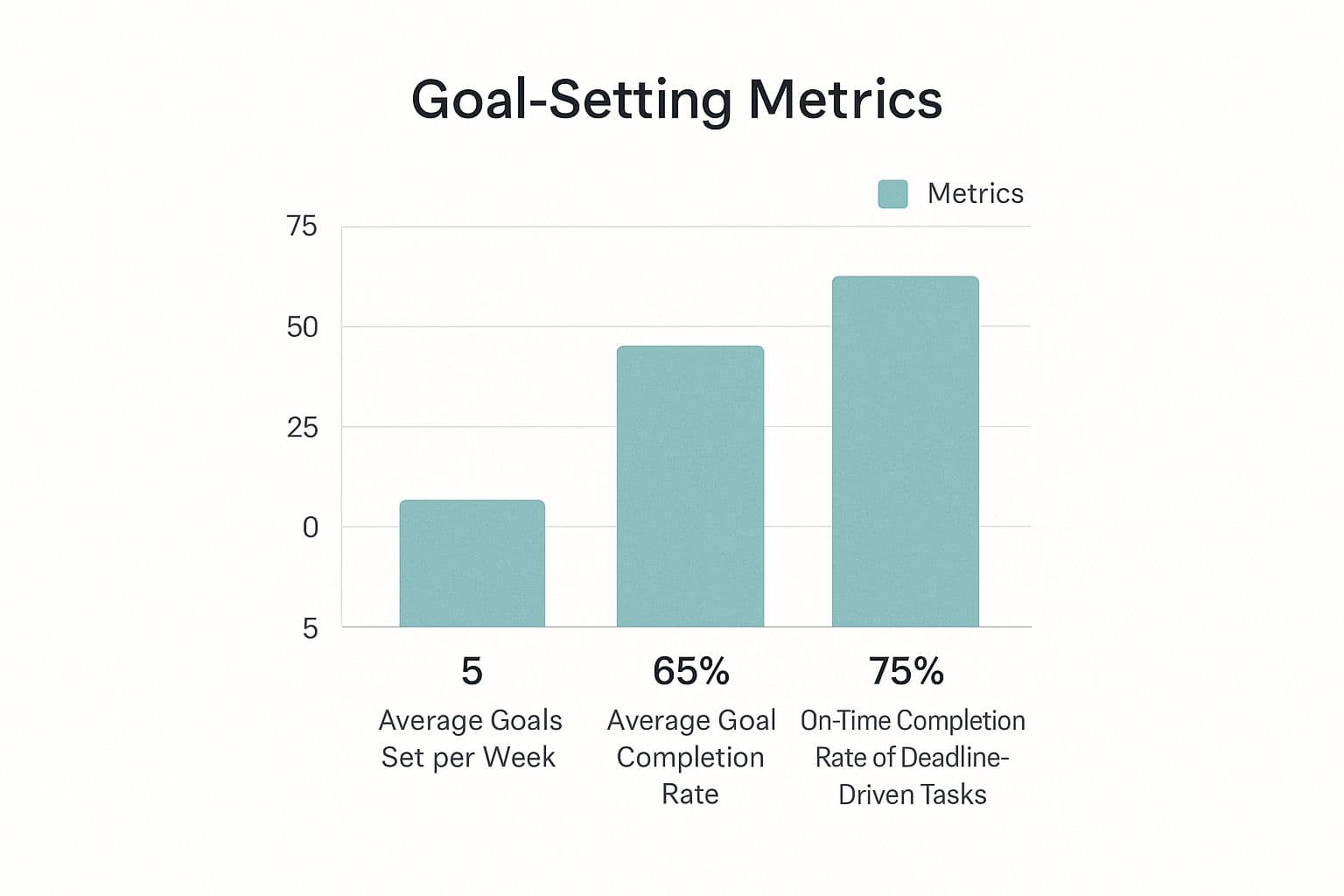Discover how to stop wasting time with proven strategies from productivity experts. Transform your daily habits and reclaim hours every week. Start today!
June 9, 2025 (6mo ago)
How to Stop Wasting Time: Real Strategies That Work
Discover how to stop wasting time with proven strategies from productivity experts. Transform your daily habits and reclaim hours every week. Start today!
← Back to blog
Where Your Hours Actually Disappear (The Uncomfortable Truth)
Let’s be honest, where does your time actually go? I’ve worked with so many professionals who feel perpetually behind, and I’ve started to see some uncomfortable patterns emerge. That nagging feeling of being busy all day but not getting anything meaningful done? It’s a real thing, and there’s a reason for it. We're going to dig into some of the sneaky time wasters hiding in plain sight.
One of the biggest offenders? Multitasking**. I know, it feels productive, like you’re a superhero juggling a million things at once. But in reality, it’s sabotaging your output. Think about it: how many times has a "quick" email check spiraled into a lost hour? Or how about that constant back-and-forth between Slack, project updates, and social media? Exhausting, right? And honestly, pretty ineffective.
Then there are those urgent tasks that seem to constantly demand your attention. They feel so important because they deliver a quick hit of dopamine – a fleeting sense of accomplishment. The problem? They derail your truly important work—those deep, focused efforts that actually make a difference. This brings us to another hidden time thief: context switching. Every time you shift gears from one task to another, your brain has to reorient itself. Imagine a car constantly stopping and starting – it guzzles gas and wears down the engine faster. Your brain needs recovery time, too.
Let me share some hard-hitting stats with you. Knowledge workers spend a whopping 88% of their workweek on communication, including emails and meetings. This really underscores the need for better time management strategies to minimize unproductive time spent in these activities. There’s some good news here: since 2020, time spent in unproductive meetings has decreased from 82 to 78 hours per year – a small but hopeful sign that we’re getting better at managing meetings. Still, 43% of people say that frequent task switching drains their energy, leading to lower productivity and, you guessed it, wasted time. Check out more insights on time management statistics.

To illustrate this further, let's look at some common time wasters and their impact:
Let's look at some common time wasters and their hidden cost:
Common Time Wasters vs. Their Hidden Impact
A comparison showing typical time-wasting activities and their actual productivity cost per week
| Time Waster | Average Time Lost | Hidden Productivity Cost | Quick Fix |
|---|---|---|---|
| Unnecessary Meetings | 2 hours | Missed deadlines, stalled projects | Implement a strict meeting agenda and time limit. Only invite essential personnel. |
| Social Media Distractions | 1.5 hours | Reduced focus, decreased output | Schedule specific times for social media checks. Use website blockers during work hours. |
| Email Overload | 3 hours | Constant interruptions, difficulty concentrating | Batch process emails at set times. Unsubscribe from unnecessary newsletters. |
| Multitasking | 2.5 hours | Inefficient work, increased error rate | Focus on one task at a time. Use the Pomodoro Technique to maintain focus. |
As you can see, seemingly small distractions can add up to significant productivity losses. Taking even small steps to address these issues can make a big difference.
The first step to taking back your time is recognizing your personal time-wasting patterns. This isn’t about beating yourself up; it’s about gaining awareness. Once you understand the why behind your habits, you can start making real, lasting changes. So, how do you find these hidden time sucks? That’s what we’ll explore next, so you can ditch the time wasters and focus on what truly matters.
Making Important Work Actually Happen (Beyond Todo Lists)
Let’s be honest, most priority systems just don't work. They look fantastic on paper, like the Eisenhower Matrix, but fall apart in real life. Why? Because they forget we’re human! I've seen incredibly talented people get tripped up by these supposedly "perfect" systems. They crumble under the pressure of everyday life. So, let's ditch the theory and talk about what really gets things done.
I’ve talked to successful entrepreneurs and busy parents who’ve mastered work-life integration, and I’ve discovered a few frameworks that actually stick. The secret? Understanding the difference between busy work (stuff that feels important) and breakthrough work (the stuff that actually moves the needle). That's where the 3-2-1 priority system comes into play.
It's ridiculously simple: 3 big things for the week, 2 medium things for the day, and 1 small win to kickstart your morning. This system prevents overwhelm while ensuring your most important goals get the attention they deserve.

The infographic above shows some interesting stats about goals and tasks. We tend to set around 5 goals per week, but our completion rate is only about 65%. For tasks with deadlines, it’s closer to 75%. This highlights a major gap between our intentions and our actions. We aim high, but often struggle to follow through. Part of conquering time-wasting is setting realistic goals and prioritizing effectively.
But the real hurdle? The emotional side of prioritizing. Saying “no” is tough. It feels like we’re letting people down or missing opportunities. But protecting your time and energy is non-negotiable if you want to reach your goals. For example, I used to attend every meeting, even if my presence wasn't crucial. I started using a simple script: “Thanks for the invite! I’m swamped this week, but please send me the notes so I can stay updated.” This let me politely decline without causing any friction.
You might also find this helpful: Check out our guide on the time management quadrant for a deeper dive into this topic.
Protecting Your High-Impact Time
Another essential piece of the puzzle is protecting your high-impact time. For me, that means blocking off my mornings for focused work. Notifications off, unnecessary tabs closed – it's all about dedicating those precious hours to my most important tasks. It’s been a game-changer.
I have a friend, a busy entrepreneur, who transformed her business by implementing a similar strategy. She carved out Friday afternoons as her "strategic thinking" time, solely for long-term planning, free from any other commitments. This allowed her to zoom out and focus on the big picture, which ultimately led to significant growth for her company.
Let’s talk about priority systems. Below is a comparison of some traditional and modern approaches.
| Method | Complexity | Real-World Success Rate | Best For |
|---|---|---|---|
| Eisenhower Matrix | High | Moderate | Analyzing urgent/important tasks |
| Simple To-Do Lists | Low | Low | Basic task management |
| 3-2-1 System | Low | High | Maintaining focus on key goals |
| Time Blocking | Medium | High | Protecting focused work time |
| Pareto Principle (80/20) | Low | High | Identifying high-impact activities |
This table highlights how simpler systems, focused on key goals and protected time, often yield greater success than complex methods.
Practice Makes Perfect
Finally, remember that prioritizing is a skill you hone over time. Don't beat yourself up if it’s not perfect at first. Experiment with different systems, find what clicks for you, and tweak it as needed. By concentrating on your most important work and learning the power of "no," you can take back your time and crush your goals.
Time Blocking Without The Rigid Schedule Prison
Time blocking often gets a bad rap. People picture themselves chained to their calendars, feeling trapped and stressed. I get it. I’ve been there, made all the classic mistakes, but I also figured out how to make it actually work. The key? Flexibility. It’s not about a rigid, unbreakable schedule. It’s about a framework that supports you, not controls you.
Think of it as hard blocks and soft blocks. Hard blocks are your non-negotiables. For me, that’s writing first thing in the morning. It's when I'm most productive, so I protect that time fiercely. Soft blocks, on the other hand, are more fluid. These are tasks that can be shifted around if needed – things like meetings, errands, or answering emails. This flexibility is what keeps time blocking from feeling like a prison.

This screenshot from Wikipedia's Time Blocking page shows how time blocking can structure your day. You can see how specific activities are assigned to particular time slots. But remember, it’s a guide, not a mandate. Life rarely fits perfectly into neat little boxes, so embrace the fluidity.
And don't forget buffer time. Seriously, this is essential. It's your cushion, your safety net. Because things will come up. A call runs long, your dog decides to eat your internet cable, or you just underestimate how long a task will take. Buffers prevent those hiccups from turning into full-blown derailments. I usually add 15 minutes between blocks – just enough breathing room to keep me sane and on track.
Handling Interruptions and Energy Levels
So, what happens when you do get interrupted during a hard block? That's where mindful decision-making comes in. It’s not about ignoring everything, but about consciously choosing how to respond. Can it wait? Can you quickly address it and get back to your focused work? Or does it require a reshuffle of your blocks? This is about taking back control of your time. For a more detailed look at creating effective time blocks, check out our guide on time-blocking schedule templates.
Another key aspect is understanding your own energy levels. Are you a morning person or a night owl? When are you most focused? When does that afternoon slump hit? Schedule your most demanding tasks for your peak energy periods. I’ve learned that my creative writing is best in the mornings, so that's when I schedule it. Afternoons are reserved for less intensive tasks like email and admin.
Adapting Time Blocking to Your Style
Time blocking should work for you, not the other way around. Experiment. Try different block lengths. Some people like long, uninterrupted stretches, while others prefer shorter bursts with frequent breaks. Find what works best for your personality and work style. Time blocking shouldn't be restrictive. It should be a supportive structure that helps you accomplish more, stress less, and own your time. It's about designing a system that empowers you to stop wasting time and focus on what truly matters.
Building Real Focus In A Distracted World
Let's be honest, staying focused these days feels like a Herculean effort. Our attention is constantly bombarded with notifications, pings, and endless distractions. I know, I've been there. Generic focus tips just don't cut it. So, through a lot of trial and error, and by talking with people who somehow manage deep work in even the most chaotic environments, I’ve picked up a few things that actually work. And it's not about silencing every distraction – that's unrealistic and often backfires. It's about creating an environment and a mindset that encourages real focus.
One of my most successful strategies is using focus triggers. These are simple actions or routines that tell your brain it's time to buckle down and concentrate. For me, it's lighting a specific candle and putting on my noise-canceling headphones. It sounds almost too simple, but it's surprisingly effective. Over time, your brain starts to associate these triggers with focused work, making it easier to slip into that concentrated state quickly, even when you only have a few minutes to spare.
Rethinking Popular Focus Tools
Here's something to consider: some of those popular focus tools might actually be hurting your concentration. Take constant notifications, for example. Even if they're work-related, those pings and buzzes constantly interrupt your flow. Every single notification pulls you out of what you're doing, forcing your brain to reorient itself. This constant context switching is mentally draining and makes it incredibly tough to focus for extended periods. If you're struggling with this, our article on how to stay focused at work offers some practical tips for minimizing distractions and getting more done.
Environmental Changes That Matter
Your physical environment plays a huge role, too. Even small changes can make a big difference. For example, I discovered that simply decluttering my workspace significantly improved my focus. A clean, organized environment can actually create mental space, allowing you to concentrate more effectively. Experiment with different setups. Maybe you thrive in a quiet room with natural light, or perhaps you prefer the low hum of a coffee shop. Find what works best for you and design a workspace that supports deep work.
The Mental Game of Focus
Focusing also has a lot to do with your mental and emotional state. Disconnecting can be surprisingly anxiety-inducing. We worry about missing something important, or feel guilty for not being instantly available. I used to struggle with this constantly, checking my email every few minutes convinced I was missing something crucial. But all I was really doing was interrupting my flow and making it harder to get anything done.
One strategy that helped me immensely was scheduling specific times for checking email and messages. This lets you stay connected without the constant interruptions, and gives you a sense of control, reducing the anxiety of disconnection. Another surprisingly effective technique is learning to use boredom strategically. When we're constantly stimulated, our brains become accustomed to a high level of input. This makes it harder to focus on tasks that require sustained attention. Embracing moments of boredom, without immediately reaching for your phone or another distraction, can actually strengthen your focus. It's like a mental muscle you can train.
Finding Your Personal Focus Formula
There's no one-size-fits-all solution for focus. What works for me might not work for you. The key is to experiment, pay attention to what helps you concentrate, and adjust your approach as needed. This is a journey of self-discovery, understanding your unique challenges, and developing strategies that empower you to stop wasting time and achieve real focus in a world designed to distract you.
Smart Delegation And Automation That Actually Helps

This screenshot gives you a peek into Fluidwave's interface, showing how it handles task management and delegation. The layout makes it easy to see how tasks are assigned and tracked, highlighting the platform's streamlined workflow. This clear visual organization is key to managing tasks and delegating effectively, which plays a big role in reclaiming your time.
Real productivity isn't about burning yourself out; it's about working smarter. It's about strategically getting rid of tasks that drain you so you can focus on what truly moves the needle. I've talked with entrepreneurs who've scaled their businesses and busy professionals who've taken back their evenings. The common thread? The power of delegation and automation. One common source of wasted time is a lack of focus, often linked to brain fog. If that's something you're dealing with, this article on clearing brain fog might be helpful.
Identifying Delegation Opportunities
Let's talk about delegation. It's not just about dumping tedious chores; it's about strategically handing off responsibilities that don't need your specific skills. Think about it: are you spending hours on tasks someone else could do just as well, or even better?
I used to waste so much time formatting blog posts. I dreaded it. Passing this off to a virtual assistant freed up hours every week, letting me focus on writing – what I enjoy and what I'm good at. This not only saved time, it improved my work.
The Power of AI Automation
Next up: automation. It’s more than scheduling social media. It’s about automating repetitive decisions so you can free up mental space for bigger things.
Think about those recurring tasks that follow a predictable pattern. Can you create a system or use a tool to automate them? I automated my email responses to common questions, which saved me tons of clicks and mental energy every day. That allowed me to spend my time on more thoughtful communications.
Fluidwave: Your AI-Powered Productivity Partner
Fluidwave's AI-powered platform changes the game for automating these kinds of routine decisions. Its intelligent automation features tackle recurring tasks, freeing you to focus on strategic work. This isn't about replacing humans; it’s about making us better.
Fluidwave combines AI automation with the help of skilled virtual assistants. You can delegate with confidence, knowing tasks will be handled efficiently. You pay only for completed work, getting real value for your investment. It's a great way to ditch low-impact activities and focus on what truly matters.
The Mindset Shift: Letting Go of Control
One of the biggest hurdles to delegation and automation is letting go of control. Many high-achievers struggle with this. We feel we have to do everything ourselves to make sure it's done right. This mindset is a trap. It keeps us stuck doing busywork and prevents us from having a bigger impact.
Trusting systems and other people can be tough, but it’s essential for reclaiming your time and energy. Start small. Delegate a few low-stakes tasks and see how it goes. As you build trust, you can delegate more complex things. This gradual approach makes the transition smoother and helps you see the power of letting go.
Energy Management: The Missing Piece Of Productivity
Let's be honest, time management without energy management is like having a fancy sports car with no fuel. What's the point of a perfect schedule if you're too drained to follow it? I've been there, and talking with others who’ve faced burnout taught me one thing: how you feel physically directly impacts how well you use your time.
The old "work-life balance" idea can be a trap. It feels like a constant struggle, right? Instead, think about integration. Work and life exist together – supporting each other instead of fighting for your attention. Learning to delegate tasks effectively can be a huge help in freeing up time and making this integration smoother.
This leads us to something called ultradian rhythms. These are your body's natural energy cycles. We all have times when we’re super focused, followed by periods of brain fog. That’s your ultradian rhythm in action. Working with these cycles – scheduling tough tasks for your peak energy times – is a real game-changer. For me, mornings are when I'm at my sharpest, so that’s when I tackle big projects.
Recovery: The Secret Weapon
Here’s a secret: real recovery actually boosts your productive hours. Powering through exhaustion feels like you’re getting things done, but it’s a fast track to burnout. Think of your energy like a bank account. You can’t keep withdrawing without making deposits. Rest, breaks, and things that recharge you are those deposits. A popular strategy for better time management is the compressed workweek, like the 4-day workweek, which has made 81% of US employees happier and just as productive. That happiness translates into better focus and less wasted time from burnout. Want to learn more about managing time? Check this out.
Practical Strategies for Sustainable Energy
So, how do you manage your energy? Here are a few tips that have worked for me:
-
Prioritize Sleep: It’s the foundation of a productive day. Aim for 7-8 hours of good sleep.
-
Regular Breaks: Stand up and move hourly, even for just a few minutes. It’ll sharpen your focus.
-
Hydration and Nutrition: Your brain needs fuel! Stay hydrated and eat nutritious food throughout the day.
-
Mindfulness and Meditation: Even a few minutes can help you tune in to your body and recognize when your energy is dipping.
Sustainable energy isn’t about quick fixes; it’s a long-term strategy. It’s about learning your body's rhythms, prioritizing recovery, and using practical strategies. Focusing on energy management doesn’t just save time; it builds a more fulfilling and productive way of working. It’s not about squeezing every last drop out of yourself; it's about working with your energy, not against it.
Your Personal Time Freedom Blueprint
Knowledge without action is just…well, more knowledge. This section takes everything we've discussed and turns it into a practical, 30-day plan. I've helped tons of people get their time back, and this blueprint is based on what actually works – building momentum with quick wins while making lasting changes to how you manage your time.
Daily Practices and Weekly Reviews
Think small, consistent actions that add up over time. For example, you might spend the first 15 minutes of your workday prioritizing your to-do list. This sets the tone for a focused, productive day, not a reactive one. These daily practices are designed to fit into your life – no need for perfect conditions.
We’ll also use weekly review templates. These aren’t about micromanaging; they’re about seeing what’s working, what’s not, and tweaking your approach. Think of it as a quick check-in with yourself, a chance to recalibrate and stay on course.
Accountability and Progress Tracking
Even if you're working solo, having some accountability can make a big difference. This might mean sharing your goals with a friend, joining an online community, or even just writing them down. Tracking your progress is important too, but we'll focus on what you value, not just arbitrary metrics. If your goal is to spend more time with your family, that's what we'll track. It’s about making sure your actions align with your priorities.
Handling Setbacks and Adapting the System
Let's be real: setbacks happen. Life throws curveballs. Kids get sick, deadlines shift, unexpected things pop up. That's why this system is designed to be flexible. We'll build in strategies to handle these bumps in the road without derailing your progress. It's about adapting to your life, not trying to force yourself into a one-size-fits-all mold.
You'll also learn how to define and measure success in a way that keeps you motivated beyond the initial excitement. This isn't about a 30-day sprint; it’s about building sustainable habits that stick. Ready to take control of your time and achieve real time freedom? Fluidwave can help. Our AI-powered platform combines intelligent automation with skilled virtual assistants to streamline your workflow and give you back your time. Learn more about how Fluidwave can transform your productivity at fluidwave.com
Focus on What Matters.
Experience lightning-fast task management with AI-powered workflows. Our automation helps busy professionals save 4+ hours weekly.